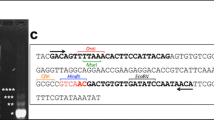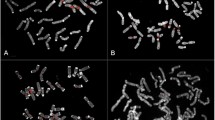Abstract
A 69-kb Indian muntjac bacterial artificial chromosome (BAC) clone that screened positive for Cervid satellites I and IV was selected for complete sequence analysis and further characterization. The sequences of this BAC clone were found in the centromeres and in some interstitial sites of Indian muntjac chromosomes. Sequence analyses showed that the BAC clone contained a 14.5 kb Cervid satellite I-like DNA element and a 9 kb Cervid satellite IV-like DNA element. In addition, it contained 51 regions each organized in a complex fashion, with sequences homology to intersperse repetitive sequences such as LINEs, SINEs, LTRs, other published DNA elements, and unassigned sequences. The FISH patterns of seven non-satellite sequence elements generated from the BAC clone showed mainly specific to centromeres of the Indian muntjac representing novel centromeric DNAs of the species. Furthermore, FISH signals and Southern blot patterns of these elements suggest the existence of a not yet identified repetitive sequence with giant repeated monomers. Positive FISH signals of these elements were also detected in the centromeric regions of Formosan muntjac. This suggests that these newly identified non-Cervid satellite DNA sequences have been conserved in the centromere of the Formosan muntjac.







Similar content being viewed by others
Abbreviations
- BAC:
-
Bacterial artificial chromosome
- FISH:
-
Fluorescence in situ hybridization
- LINEs:
-
Long interspersed nucleotide elements
- SINEs:
-
Short interspersed nucleotide elements
- LTRs:
-
Long terminal repeats
References
Bogenberger JM, Neitzel H, Fittler F (1987) A highly repetitive DNA component common to all cervodae: its organization and chromosomal distribution during evolution. Chromosoma 95:154–161
Brinkley BR, Valdivia MM, Tousson A, Brenner SL (1984) Compound kinetochores of the Indian muntjac: evolution by linear fusion of unit kinetochores. Chromosoma 91:1–11
Chi JX, Huang L, Nie W, Wang J, Su B, Yang F (2005) Defining the orientation of the tandem fusions that occurred during the evolution of Indian muntjac chromosomes by BAC mapping. Chromosoma 114:167–172
Hsu TC, Pathak S, Chen TR (1975) The possibility of latent centromeres and a proposed nomenclature system for total chromosome and whole arm translocation. Cytogenet Cell Genet 15:41–49
Latour D, Vig BK, Finze EM, Paweletz N (1996) The centromeres of the Indian muntjac: evidence for the existence of multiple centromeres? Mutat Res 356:187–195
Lee C, Lin CC (1996) Conservation of a 31-bp bovine subrepeat in centromeric satellite DNA monomers of Cervus elaphus and other cervid species. Chromosome Res 4:427–435
Lee C, Ritchie DBC, Lin CC (1994) A tandemly repetitive, centromeric DNA sequence from the Canadian woodland caribou (Rangifer tarandus caribou): its conservation and evolution in several deer species. Chromosome Res 2:293–306
Lee C, Court DR, Cho C, Haslett JL, Lin CC (1997) Higher-order organization of subrepeats and the evolution of cervid satellite I DNA. J Mol Evol 44:327–335
Lee C, Stanyon R, Lin CC, Ferguson-Smith MA (1999) Conservation of human gamma-X centromeric DNA among primates with an autosomal location in certain OldWorld monkeys. Chromosome Res 7:43–47
Li YC, Lee C, Hsu TH, Li SY, Lin CC (2000a) Direct visualization of the genomic distribution and organization of two cervid centromeric satellite DNA families. Cytogenet Cell Genet 89:192–198
Li YC, Lee C, Sanoudou D et al (2000b) Interstitial colocalization of two cervid satellite DNAs involved in the genesis in the Indian muntjac karyotype. Chromosome Res 8:363–373
Li YC, Lee C, Chang WS, Li SY, Lin CC (2002) Isolation and identification of a novel satellite DNA family highly conserved in several Cervidae species. Chromosoma 111:176–183
Li YC, Cheng YM, Hsieh LJ et al (2005) Karyotypic evolution of a novel cervid satellite DNA family isolated by microdissection from the Indian muntjac Y-chromosome. Chromosoma 114:28–38
Lin CC, Sasi R, Fan YS, Chen ZQ (1991) New evidence for tandem chromosome fusions in the karyotypic evolution of Asian muntjacs. Chromosoma 101:19–24
Lin CC, Chiang PY, Hsieh LJ, Chao MC, Li YC (2004) Cloning, characterization and physical mapping of three cervid satellite DNA families in the genome of Formosan muntjac (Muntiacus reevesi micrurus). Cytogenet Genome Res 105:100–106
Lin CC, Hsu PC, Li TS et al (2008) Construction of an Indian muntjac BAC library and production of the most highly density FISH map of the species. Zool Stud 47:282–292
Liu Y, Nie WH, Huang L et al (2008) Cloning, characterization, and FISH mapping of four satellite DNAs from black muntjac (Muntiacus crinifrons) and Fea’s muntjac (M. feae). Zoological Research 29:225–235
Nagaki K, Song J, Stupar R, Parokonny AS, Yuan Q (2003) Molecular and cytological analyses of large tracks of centromeric DNA reveal the structure and evolutionary dynamics of maize centromeres. Genetics 163:759–770
Nagaki K, Cheng Z, Ouyang S, Talber PB, Kim M (2004) Sequencing of a rice centromere uncovers active genes. Nat Genet 36:138–145
Qureshi SA, Blake RD (1995) Sequence characteristics of a cervid DNA repeat family. J Mol Evol 40:400–404
Rattner JB (1986) Organization within the mammalian kinetochore. Chromosoma 93:515–520
Sambrook J, Russell DW (2001) Molecular cloning, a laboratory manual. Cold Spring Harbor Laboratory, Cold Spring Harbor
Scherthan H (1991) Characterization of a tandem repetitive sequence cloned from the deer Capreolus capreolus and its chromosomal localization in two muntjac species. Hereditas 115:43–49
Schueler MG, Higgins AW, Rudd MK, Gustashaw K, Willard HF (2001) Genomic and genetic definition of a functional human centromere. Science 294:109–115
Shi L, Ye Y, Duan X (1980) Comparative cytogenetic studies on the red muntjac, Chinese muntjac and their F1 hybrids. Cytogenet Cell Genet 26:22–27
Sun X, Le HD, Wahlstrom JM, Karpen GH (2003) Sequence analysis of a functional Drosophila centromere. Genome Res 13:182–194
Tsipouri V, Schueler MG, Hu S, NISC Comparative Sequencing Program, Dutra A (2008) Comparative sequence analyses reveal sites of ancestral chromosomal fusions in the Indian muntjac genome. Genome Biol 9:R155
Vafa O, Shelby RD, Sullivan KF (1999) CENP-A associated complex satellite DNA in the kinetochore of the Indian muntjac. Chromosoma 108:367–374
Wurster DH, Benirschke K (1970) Indian muntjac, Muntiacus muntjak: a deer with a low diploid chromosome number. Science 168:1364–1366
Yang F, Carter NP, Shi L, Ferguson-Smith MA (1995) A comparative study of karyotypes of muntjacs by chromosome painting. Chromosoma 103:642–652
Acknowledgements
This research was supported by grants from National Sciences Council, Taiwan (NSC96-2311-B-005-007-MY2 to Y-M Cheng; NSC95-2311-B-040-001 and NSC97-2311-B-006-003-MY3 to Y.-C Li; and NSC 97-2314-B-039-017 to C.C. Lin). A grant support from the Department of Medical Research, China medical University Hospital (DHR 94-050) to CCL is also acknowledged.
Author information
Authors and Affiliations
Corresponding author
Additional information
Responsible Editor: Fengtang Yang.
Y.-C. Li and C. C. Lin contributed equally to this work.
Rights and permissions
About this article
Cite this article
Cheng, YM., Li, TS., Hsieh, LJ. et al. Complex genomic organization of Indian muntjac centromeric DNA. Chromosome Res 17, 1051–1062 (2009). https://doi.org/10.1007/s10577-009-9097-z
Received:
Revised:
Accepted:
Published:
Issue Date:
DOI: https://doi.org/10.1007/s10577-009-9097-z




